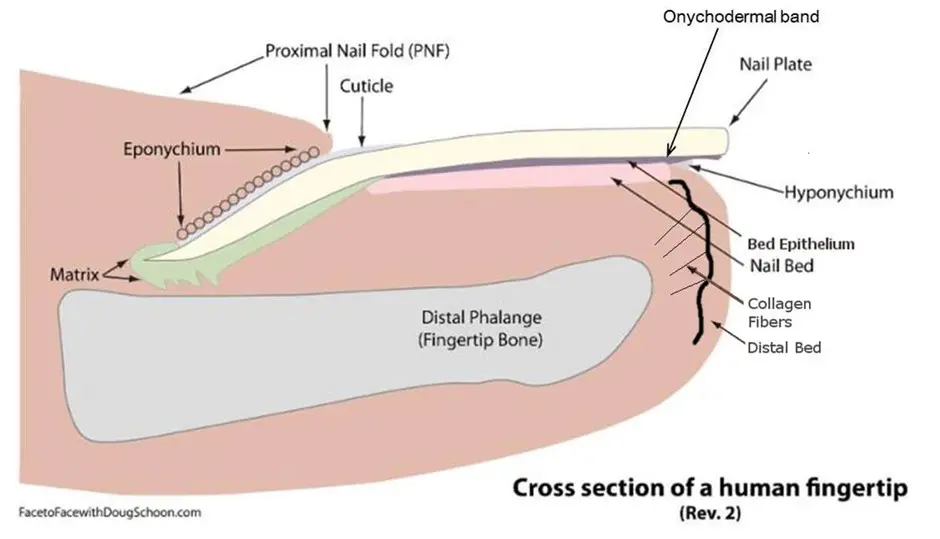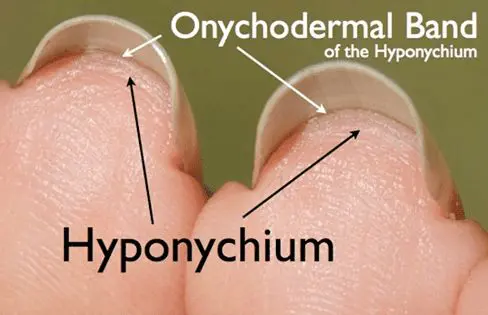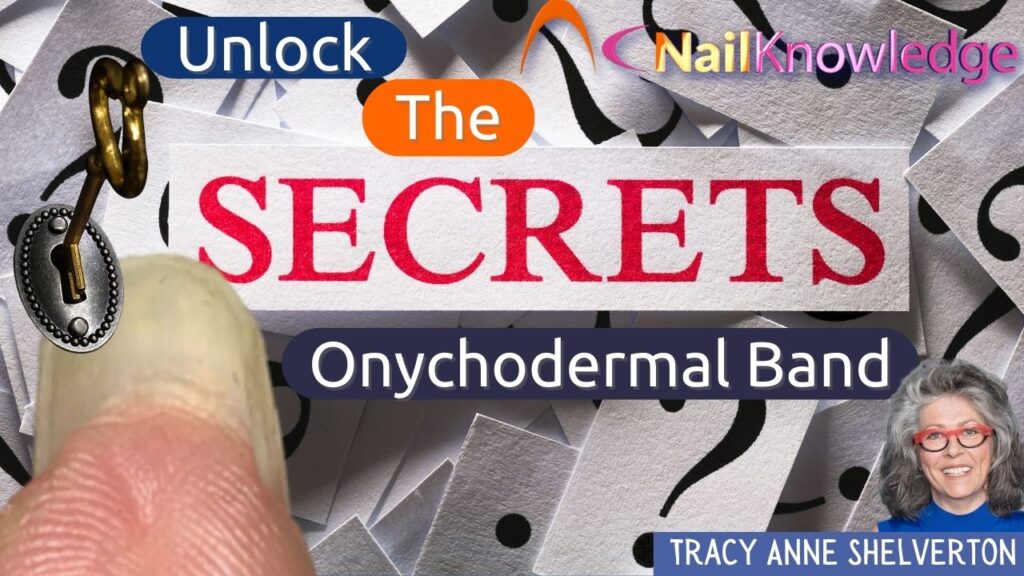Lo vemos todos los días en el trabajo, pero ¿sabemos realmente lo que es? Echemos un vistazo a la ilustración de Doug Schoon para entenderlo mejor.

Si intentamos verlo desde detrás del borde libreaparece así:

- La banda onicodérmica es un tejido no vivo. Es una extensión del epitelio del lecho.
- Tiene un color gris parduzco.
La banda onicodérmica: Una barrera protectora oculta
Entre el placa para clavos y el lecho ungueal yace la cama epitelio. Cuando el epitelio del lecho alcanza el final del lecho ungueal y se pliega sobre sí misma, se convierte en la Banda Onicodérmica. Este tejido estrecho y compactado actúa como una barrera patógena adicional por debajo de la piel libre. borde de la lámina ungueal. En formularios una asociación con la hiponiquio y juntos se convierten en un súper sello: a menudo pasa desapercibido y es casi invisible. Hay que mirar de cerca para percibirlo.
La banda onicodérmica es algo translúcida, una fina capa bajo el borde distal (borde libre) del placa para clavosque abarca toda la anchura del placa para clavos y bordeando el blanco visible del borde libre.
La banda onicodérmica sirve para impedir que los organismos infecciosos y contaminantes más pequeños se infiltren en el lecho ungueal. Si se vulnera este tejido protector (barrera patógena), la uña la placa se separa del lecho ungueal causando onicólisis and dramatically increasing the risk of infection.
Su socio en el unidad de clavos es el Hiponiquio y que el hiponiquio es uno de los cuatro precintos guardianes de la unidad de clavos, diseñado para proteger la lecho ungueal de gérmenes y otras infecciones, como hongos o levadura. Mientras que la hiponiquio está compuesta de tejido epidérmico vivo. Es importante tener en cuenta que la banda onicodérmica es tejido no vivo y necesita mantenerse elástica para desempeñar eficazmente su función.
Mejorar la elasticidad: Aplicar aceite detrás del borde libre para la salud de las uñas
Aplicación de aceite detrás del borde libre, en lugar de encima de la placa ungueal, puede ayudar a mantener la elasticidad necesaria, incluso si la banda onicodérmica ya se ha desprendido.
Medidas de precaución y consideraciones autoinmunes para el cuidado de las uñas
Cuidado al utilizar un Efile para acortar la uña que sale de un mejora de las uñas detrás del borde libre o si utiliza un instrumento afilado para limpiar debajo del borde libre, podría dañarlo accidentalmente, y verá inmediatamente las consecuencias como onicólisis.
Algunas enfermedades autoinmunes también pueden influir:
- Psoriasis
- Liquen plano
- Eczema
Todas ellas son enfermedades que pueden afectar a la banda onicodérmica, la uña matrizLa aplicación de aceite detrás del borde libre es crucial. La aplicación de aceite detrás del borde libre es crucial porque el aceite repele el agua, mantiene el sello guardián elástico y no proporciona una fuente de nutrición para los gérmenes, ofreciendo una excelente protección.
En esta imagen se ve claramente cómo puede afectarle la psoriasis. Cuando se forma la ampolla "mancha de aceite", el epitelio del lecho se ve afectado directamente por la presión ascendente de la ampolla que lo desplaza del lecho ungueal. A medida que la lámina ungueal se desplaza (movimiento perpetuo) y el epitelio dañado del lecho se acerca al borde libre, se produce la onicólisis, y el lecho ungueal queda expuesto a todas las agresiones. patógenos.

A veces, también puede notar que el hiponiquio se estira junto con la banda onicodérmica. Algo simple (pero que no siempre se nota) como la contracción del producto puede provocar fácilmente que esto ocurra. Si reconoce que esto ocurre, deje de utilizar su producto para uñas hasta que se recupere el hiponiquio o busque un producto más flexible. También en este caso, un aceite de buena calidad es tu amigo. Si trabaja con un cutícula empujador o un e-file en esta zona, es probable que provoques más irritación.
La banda onicodérmica es de suma importancia para la salud general de la unidad ungueal y debe tratarse con cuidado. Es necesario ser cauteloso durante la limpieza debajo del borde libre. Es mejor limpiar con un cepillo y aceite, evitando siempre objetos punzantes bajo el borde libre para mantener sana la unidad ungueal.
En conclusión
La banda onicodérmica puede pasar desapercibida en nuestra vida cotidiana, pero desempeña un papel crucial en la protección de nuestras uñas frente a las infecciones y en el mantenimiento de su salud general. Comprender su función y cómo cuidarla es esencial para la salud e higiene de las uñas. Así que, la próxima vez que te arregles las uñas, recuerda la importancia de la banda onicodérmica y trátala con el cuidado que se merece para que tus uñas tengan el mejor aspecto posible.


